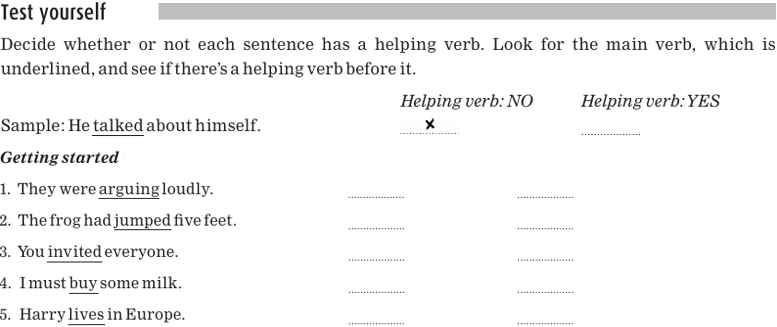
The basic structure of auxiliary phrases
 المؤلف:
EVELYNP.ALTENBERG & ROBERTM.VAGO
المؤلف:
EVELYNP.ALTENBERG & ROBERTM.VAGO
 المصدر:
English Grammar Understanding the basics
المصدر:
English Grammar Understanding the basics
 الجزء والصفحة:
P138-C12
الجزء والصفحة:
P138-C12
 2025-11-10
2025-11-10
 65
65
The basic structure of auxiliary phrases
What are some sentences with helping (auxiliary) verbs? Here are few examples, with the helping verb underlined:
1. She should study.
2. She has studied.
3. She is studying.
In these sentences, the main verb is a form of study, and the helping verb is helping to give us additional information that we can’t get from just the main verb.
There aren’t that many helping verbs; the basic ones are listed in the following Quick tip.
Quick tip
The basic helping verbs of English are:
a. can may shall will must
could might should would
b. have has had
c. am are is
was were
be been being
Now take another look at sentences 1-3, which have both a helping verb and a main verb. Which comes first? You can see that the main verb always comes after the helping verb.
Quick tip
If a sentence has both a main verb and a helping verb, the main verb is always last.
Does every sentence of English have a helping verb? Here are examples of sentences that do not have a helping verb. Each only has a main verb, which is underlined.
4. She studies every day.
5. She studied every day.
6. He leaves at 9 in the morning.
7. He left at 9 in the morning.

Answers


Answers

The helping verbs belong to different subgroups, as indicated in the first Quick tip in Modals. We’ll take a closer look at each of the three types of helping verbs later.
 الاكثر قراءة في Phrases
الاكثر قراءة في Phrases
 اخر الاخبار
اخر الاخبار
اخبار العتبة العباسية المقدسة


